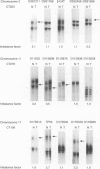Abstract
Loss of heterozygosity (LOH) frequently occurs in squamous cell carcinomas of the uterine cervix and indicates the probable sites of tumour-suppressor genes that play a role in the development of this tumour. To define the localization of these tumour-suppressor genes, we studied loss of heterozygosity in 64 invasive cervical carcinomas (stage IB and IIA) using the polymerase chain reaction with 24 primers for polymorphic repeats of known chromosomal localization. Chromosomes 3, 11, 13, 16 and 17, in particular, were studied. LOH was frequently found on chromosome 11, in particular at 11q22 (46%) and 11q23.3 (43%). LOH on chromosome 11p was not frequent. On chromosome 17p13.3, a marker (D17S513) distal to p53 showed 38% LOH, whereas p53 itself showed only 20% LOH. On the short arm of chromosome 3, LOH was frequently found (41%) at 3p21.1. The beta-catenin gene is located in this chromosomal region. Therefore, expression of beta-catenin protein was studied in 39 cases using immunohistochemistry. Staining of beta-catenin at the plasma membrane of tumour cells was present in 38 cases and completely absent in only one case. The tumour-suppressor gene on chromosome 3p21.1 may be beta-catenin in this one case, but (an)other tumour-suppressor gene(s) must also be present in this region. For the other chromosomes studied, 13q (BRCA-2) and 16q (E-cadherin), only sporadic losses (< 15% of cases) were found. Expression of E-cadherin was found in all of 37 cases but in six cases the staining was very weak. No correlation was found between clinical and histological parameters and losses on chromosome 3p, 11q and 17p. In addition to LOH, microsatellite instability was found in one tumour for almost all loci and in eight tumours for one to three loci. In conclusion, we have identified three loci with frequent LOH, which may harbour new tumour-suppressor genes, and found microsatellite instability in 14% of cervical carcinomas.
Full text
PDF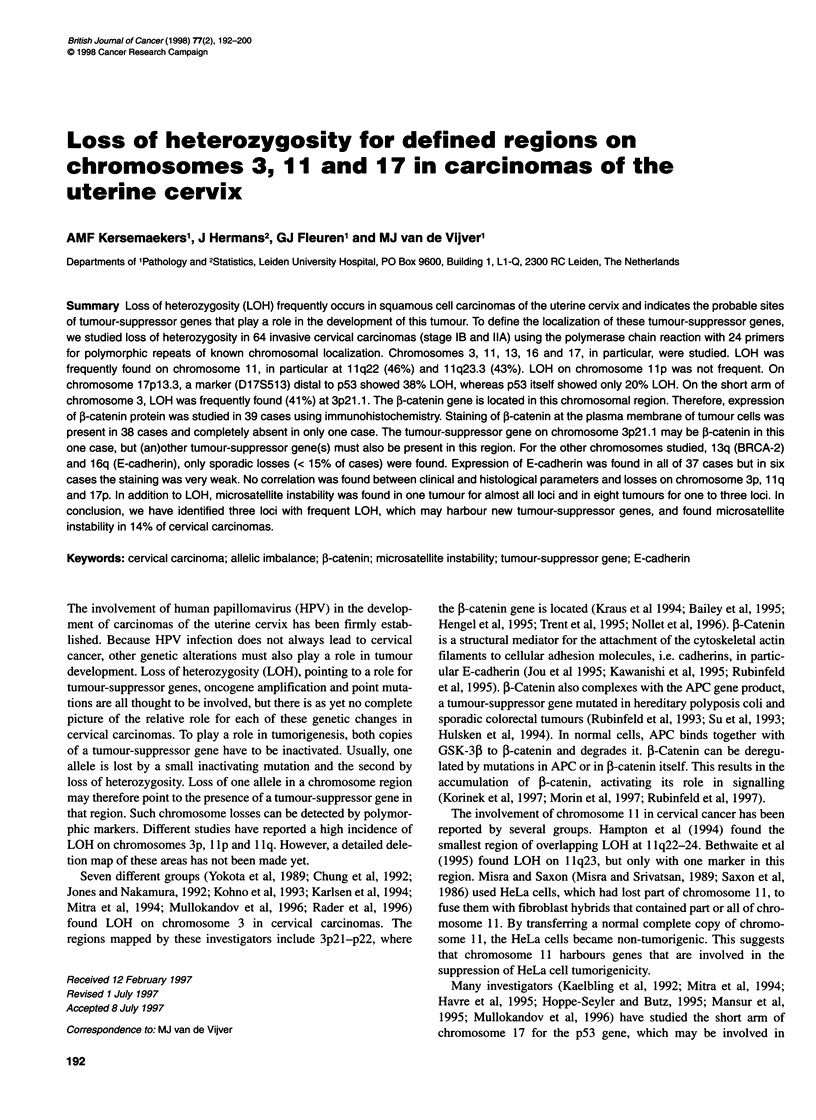
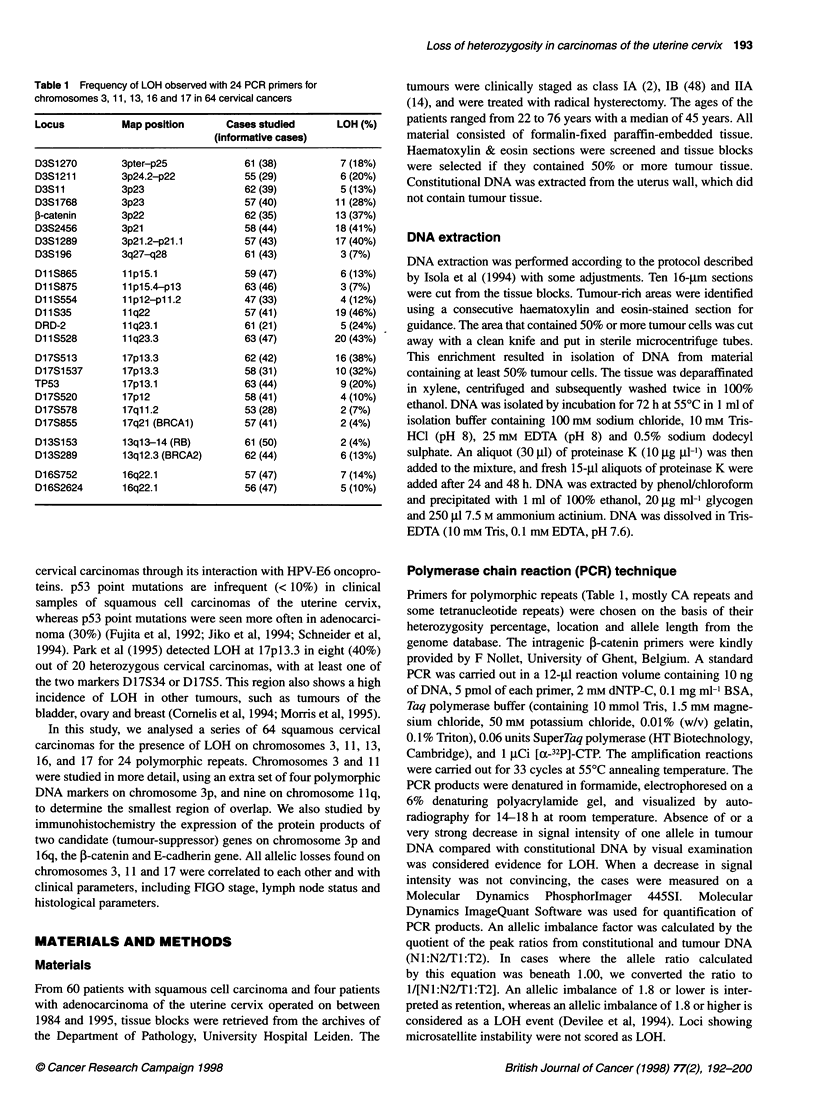
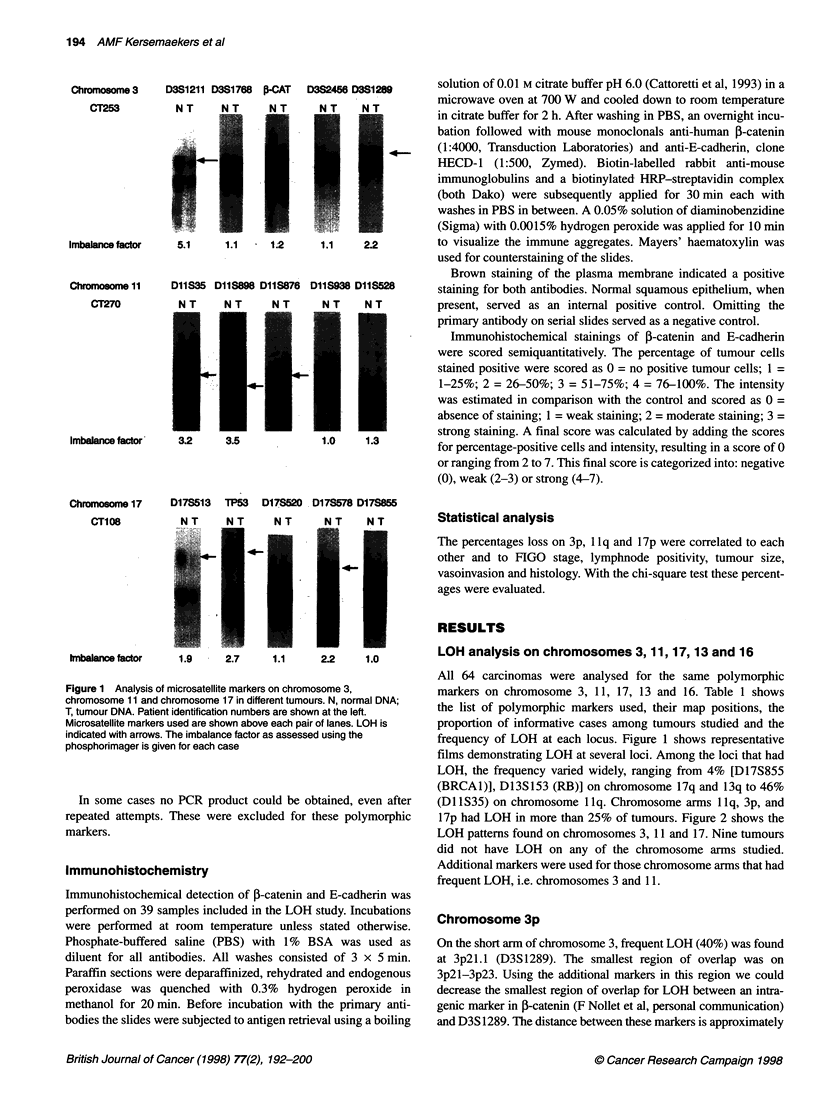

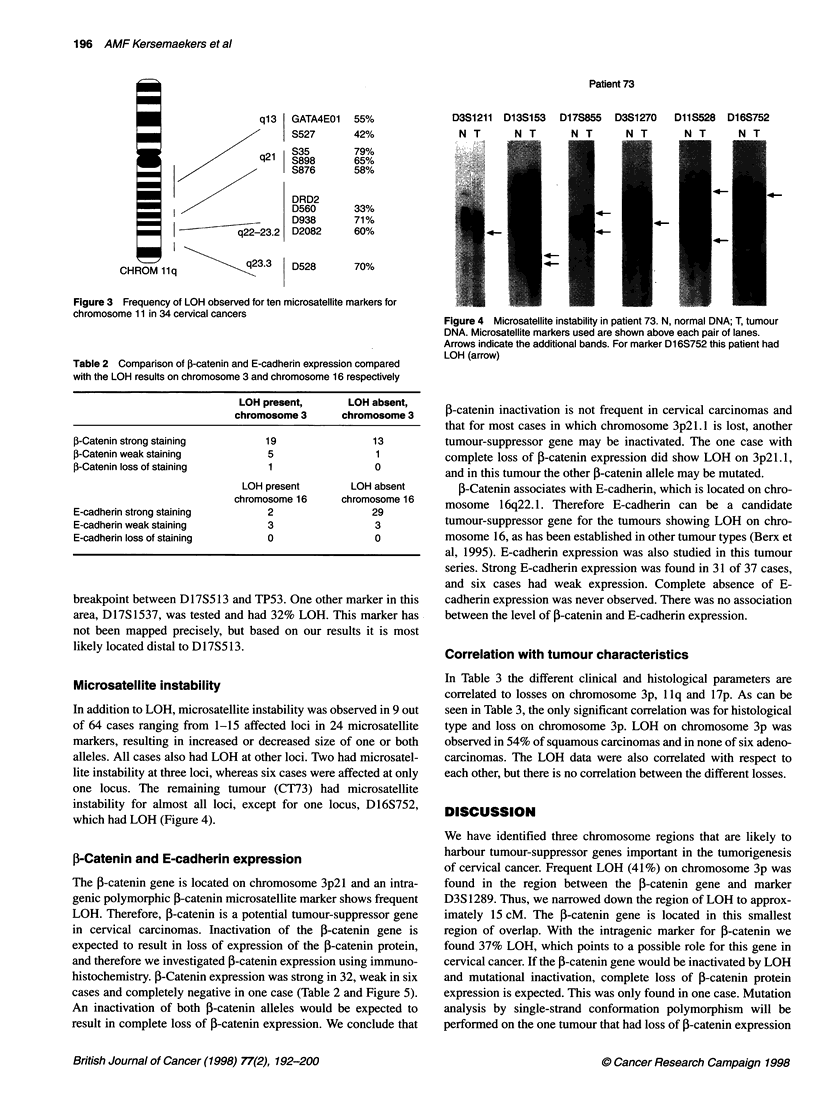

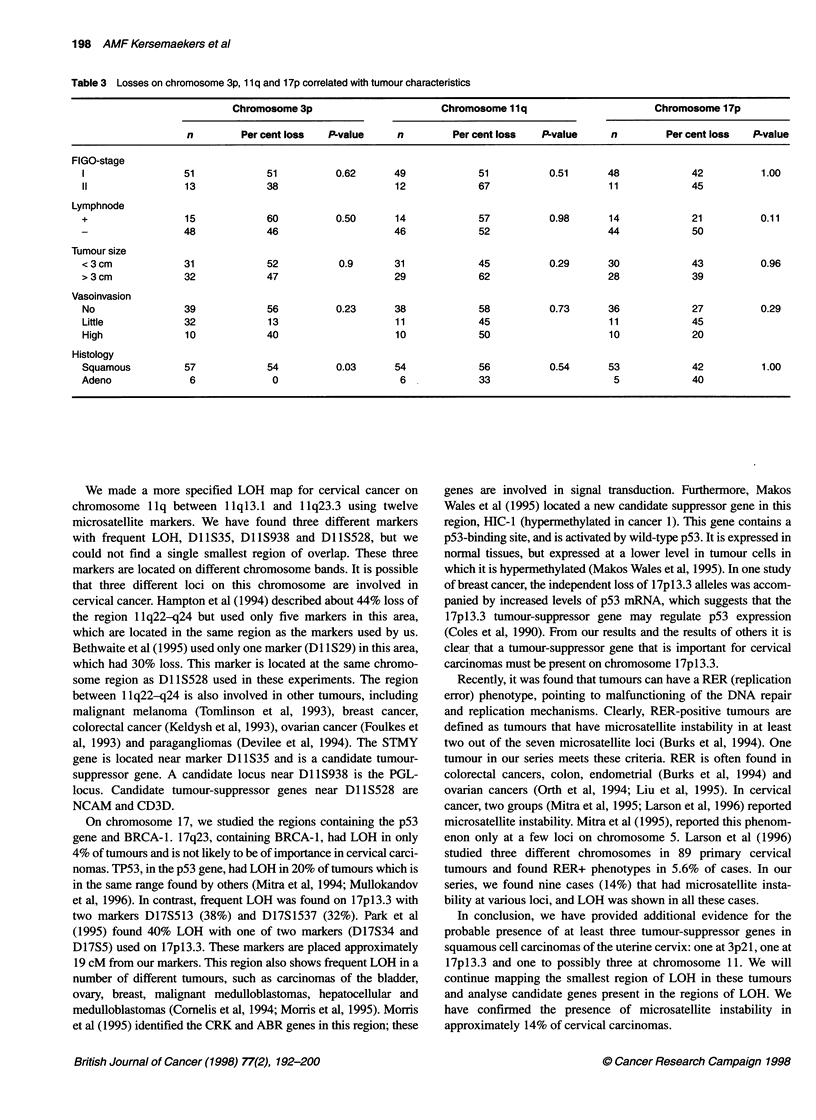

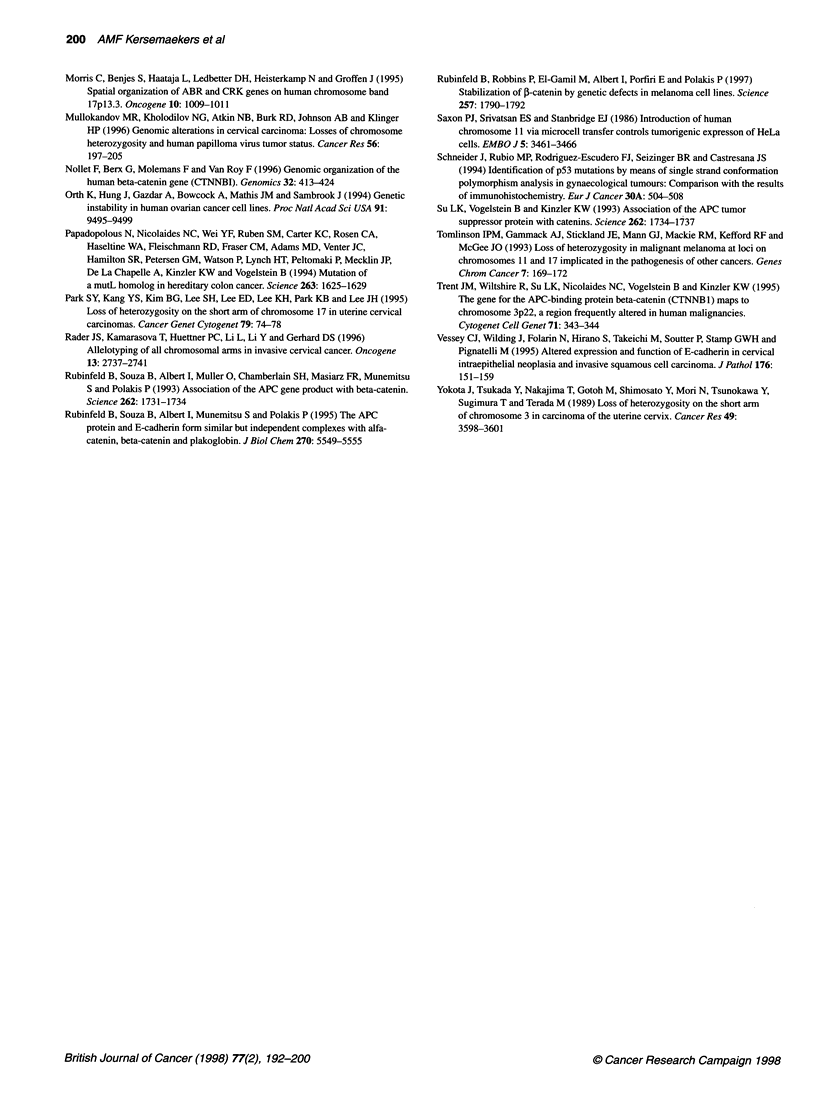
Images in this article
Selected References
These references are in PubMed. This may not be the complete list of references from this article.
- Bailey A., Norris A. L., Leek J. P., Clissold P. M., Carr I. M., Ogilvie D. J., Morrison J. F., Meredith D. M., Markham A. F. Yeast artificial chromosome cloning of the beta-catenin locus on human chromosome 3p21-22. Chromosome Res. 1995 May;3(3):201–203. doi: 10.1007/BF00710714. [DOI] [PubMed] [Google Scholar]
- Berx G., Cleton-Jansen A. M., Nollet F., de Leeuw W. J., van de Vijver M., Cornelisse C., van Roy F. E-cadherin is a tumour/invasion suppressor gene mutated in human lobular breast cancers. EMBO J. 1995 Dec 15;14(24):6107–6115. doi: 10.1002/j.1460-2075.1995.tb00301.x. [DOI] [PMC free article] [PubMed] [Google Scholar]
- Bethwaite P. B., Koreth J., Herrington C. S., McGee J. O. Loss of heterozygosity occurs at the D11S29 locus on chromosome 11q23 in invasive cervical carcinoma. Br J Cancer. 1995 Apr;71(4):814–818. doi: 10.1038/bjc.1995.157. [DOI] [PMC free article] [PubMed] [Google Scholar]
- Bronner C. E., Baker S. M., Morrison P. T., Warren G., Smith L. G., Lescoe M. K., Kane M., Earabino C., Lipford J., Lindblom A. Mutation in the DNA mismatch repair gene homologue hMLH1 is associated with hereditary non-polyposis colon cancer. Nature. 1994 Mar 17;368(6468):258–261. doi: 10.1038/368258a0. [DOI] [PubMed] [Google Scholar]
- Burks R. T., Kessis T. D., Cho K. R., Hedrick L. Microsatellite instability in endometrial carcinoma. Oncogene. 1994 Apr;9(4):1163–1166. [PubMed] [Google Scholar]
- Cattoretti G., Pileri S., Parravicini C., Becker M. H., Poggi S., Bifulco C., Key G., D'Amato L., Sabattini E., Feudale E. Antigen unmasking on formalin-fixed, paraffin-embedded tissue sections. J Pathol. 1993 Oct;171(2):83–98. doi: 10.1002/path.1711710205. [DOI] [PubMed] [Google Scholar]
- Chung G. T., Huang D. P., Lo K. W., Chan M. K., Wong F. W. Genetic lesion in the carcinogenesis of cervical cancer. Anticancer Res. 1992 Sep-Oct;12(5):1485–1490. [PubMed] [Google Scholar]
- Coles C., Thompson A. M., Elder P. A., Cohen B. B., Mackenzie I. M., Cranston G., Chetty U., Mackay J., Macdonald M., Nakamura Y. Evidence implicating at least two genes on chromosome 17p in breast carcinogenesis. Lancet. 1990 Sep 29;336(8718):761–763. doi: 10.1016/0140-6736(90)93236-i. [DOI] [PubMed] [Google Scholar]
- Cornelis R. S., van Vliet M., Vos C. B., Cleton-Jansen A. M., van de Vijver M. J., Peterse J. L., Khan P. M., Børresen A. L., Cornelisse C. J., Devilee P. Evidence for a gene on 17p13.3, distal to TP53, as a target for allele loss in breast tumors without p53 mutations. Cancer Res. 1994 Aug 1;54(15):4200–4206. [PubMed] [Google Scholar]
- Devilee P., van Schothorst E. M., Bardoel A. F., Bonsing B., Kuipers-Dijkshoorn N., James M. R., Fleuren G., van der Mey A. G., Cornelisse C. J. Allelotype of head and neck paragangliomas: allelic imbalance is confined to the long arm of chromosome 11, the site of the predisposing locus PGL. Genes Chromosomes Cancer. 1994 Oct;11(2):71–78. doi: 10.1002/gcc.2870110202. [DOI] [PubMed] [Google Scholar]
- Foulkes W. D., Campbell I. G., Stamp G. W., Trowsdale J. Loss of heterozygosity and amplification on chromosome 11q in human ovarian cancer. Br J Cancer. 1993 Feb;67(2):268–273. doi: 10.1038/bjc.1993.51. [DOI] [PMC free article] [PubMed] [Google Scholar]
- Fujita M., Inoue M., Tanizawa O., Iwamoto S., Enomoto T. Alterations of the p53 gene in human primary cervical carcinoma with and without human papillomavirus infection. Cancer Res. 1992 Oct 1;52(19):5323–5328. [PubMed] [Google Scholar]
- Gentile V., Grant F. J., Porta R., Baldini A. Localization of the human prostate transglutaminase (type IV) gene (TGM4) to chromosome 3p21.33-p22 by fluorescence in situ hybridization. Genomics. 1995 May 1;27(1):219–220. doi: 10.1006/geno.1995.1032. [DOI] [PubMed] [Google Scholar]
- Hampton G. M., Penny L. A., Baergen R. N., Larson A., Brewer C., Liao S., Busby-Earle R. M., Williams A. W., Steel C. M., Bird C. C. Loss of heterozygosity in cervical carcinoma: subchromosomal localization of a putative tumor-suppressor gene to chromosome 11q22-q24. Proc Natl Acad Sci U S A. 1994 Jul 19;91(15):6953–6957. doi: 10.1073/pnas.91.15.6953. [DOI] [PMC free article] [PubMed] [Google Scholar]
- Havre P. A., Yuan J., Hedrick L., Cho K. R., Glazer P. M. p53 inactivation by HPV16 E6 results in increased mutagenesis in human cells. Cancer Res. 1995 Oct 1;55(19):4420–4424. [PubMed] [Google Scholar]
- Hemminki A., Peltomäki P., Mecklin J. P., Järvinen H., Salovaara R., Nyström-Lahti M., de la Chapelle A., Aaltonen L. A. Loss of the wild type MLH1 gene is a feature of hereditary nonpolyposis colorectal cancer. Nat Genet. 1994 Dec;8(4):405–410. doi: 10.1038/ng1294-405. [DOI] [PubMed] [Google Scholar]
- Hoppe-Seyler F., Butz K. Molecular mechanisms of virus-induced carcinogenesis: the interaction of viral factors with cellular tumor suppressor proteins. J Mol Med (Berl) 1995 Nov;73(11):529–538. doi: 10.1007/BF00195138. [DOI] [PubMed] [Google Scholar]
- Hülsken J., Birchmeier W., Behrens J. E-cadherin and APC compete for the interaction with beta-catenin and the cytoskeleton. J Cell Biol. 1994 Dec;127(6 Pt 2):2061–2069. doi: 10.1083/jcb.127.6.2061. [DOI] [PMC free article] [PubMed] [Google Scholar]
- Inoue M., Ogawa H., Miyata M., Shiozaki H., Tanizawa O. Expression of E-cadherin in normal, benign, and malignant tissues of female genital organs. Am J Clin Pathol. 1992 Jul;98(1):76–80. doi: 10.1093/ajcp/98.1.76. [DOI] [PubMed] [Google Scholar]
- Isola J., DeVries S., Chu L., Ghazvini S., Waldman F. Analysis of changes in DNA sequence copy number by comparative genomic hybridization in archival paraffin-embedded tumor samples. Am J Pathol. 1994 Dec;145(6):1301–1308. [PMC free article] [PubMed] [Google Scholar]
- Jiko K., Tsuda H., Sato S., Hirohashi S. Pathogenetic significance of p53 and c-Ki-ras gene mutations and human papillomavirus DNA integration in adenocarcinoma of the uterine cervix and uterine isthmus. Int J Cancer. 1994 Dec 1;59(5):601–606. doi: 10.1002/ijc.2910590505. [DOI] [PubMed] [Google Scholar]
- Jones M. H., Nakamura Y. Deletion mapping of chromosome 3p in female genital tract malignancies using microsatellite polymorphisms. Oncogene. 1992 Aug;7(8):1631–1634. [PubMed] [Google Scholar]
- Jou T. S., Stewart D. B., Stappert J., Nelson W. J., Marrs J. A. Genetic and biochemical dissection of protein linkages in the cadherin-catenin complex. Proc Natl Acad Sci U S A. 1995 May 23;92(11):5067–5071. doi: 10.1073/pnas.92.11.5067. [DOI] [PMC free article] [PubMed] [Google Scholar]
- Kaelbling M., Burk R. D., Atkin N. B., Johnson A. B., Klinger H. P. Loss of heterozygosity on chromosome 17p and mutant p53 in HPV-negative cervical carcinomas. Lancet. 1992 Jul 18;340(8812):140–142. doi: 10.1016/0140-6736(92)93214-8. [DOI] [PubMed] [Google Scholar]
- Karlsen F., Rabbitts P. H., Sundresan V., Hagmar B. PCR-RFLP studies on chromosome 3p in formaldehyde-fixed, paraffin-embedded cervical cancer tissues. Int J Cancer. 1994 Sep 15;58(6):787–792. doi: 10.1002/ijc.2910580606. [DOI] [PubMed] [Google Scholar]
- Kawanishi J., Kato J., Sasaki K., Fujii S., Watanabe N., Niitsu Y. Loss of E-cadherin-dependent cell-cell adhesion due to mutation of the beta-catenin gene in a human cancer cell line, HSC-39. Mol Cell Biol. 1995 Mar;15(3):1175–1181. doi: 10.1128/mcb.15.3.1175. [DOI] [PMC free article] [PubMed] [Google Scholar]
- Keldysh P. L., Dragani T. A., Fleischman E. W., Konstantinova L. N., Perevoschikov A. G., Pierotti M. A., Della Porta G., Kopnin B. P. 11q deletions in human colorectal carcinomas: cytogenetics and restriction fragment length polymorphism analysis. Genes Chromosomes Cancer. 1993 Jan;6(1):45–50. doi: 10.1002/gcc.2870060109. [DOI] [PubMed] [Google Scholar]
- Kohno T., Takayama H., Hamaguchi M., Takano H., Yamaguchi N., Tsuda H., Hirohashi S., Vissing H., Shimizu M., Oshimura M. Deletion mapping of chromosome 3p in human uterine cervical cancer. Oncogene. 1993 Jul;8(7):1825–1832. [PubMed] [Google Scholar]
- Korinek V., Barker N., Morin P. J., van Wichen D., de Weger R., Kinzler K. W., Vogelstein B., Clevers H. Constitutive transcriptional activation by a beta-catenin-Tcf complex in APC-/- colon carcinoma. Science. 1997 Mar 21;275(5307):1784–1787. doi: 10.1126/science.275.5307.1784. [DOI] [PubMed] [Google Scholar]
- Kraus C., Liehr T., Hülsken J., Behrens J., Birchmeier W., Grzeschik K. H., Ballhausen W. G. Localization of the human beta-catenin gene (CTNNB1) to 3p21: a region implicated in tumor development. Genomics. 1994 Sep 1;23(1):272–274. doi: 10.1006/geno.1994.1493. [DOI] [PubMed] [Google Scholar]
- Larson A. A., Kern S., Sommers R. L., Yokota J., Cavenee W. K., Hampton G. M. Analysis of replication error (RER+) phenotypes in cervical carcinoma. Cancer Res. 1996 Mar 15;56(6):1426–1431. [PubMed] [Google Scholar]
- Liu B., Nicolaides N. C., Markowitz S., Willson J. K., Parsons R. E., Jen J., Papadopolous N., Peltomäki P., de la Chapelle A., Hamilton S. R. Mismatch repair gene defects in sporadic colorectal cancers with microsatellite instability. Nat Genet. 1995 Jan;9(1):48–55. doi: 10.1038/ng0195-48. [DOI] [PubMed] [Google Scholar]
- Mansur C. P., Marcus B., Dalal S., Androphy E. J. The domain of p53 required for binding HPV 16 E6 is separable from the degradation domain. Oncogene. 1995 Feb 2;10(3):457–465. [PubMed] [Google Scholar]
- Misra B. C., Srivatsan E. S. Localization of HeLa cell tumor-suppressor gene to the long arm of chromosome II. Am J Hum Genet. 1989 Oct;45(4):565–577. [PMC free article] [PubMed] [Google Scholar]
- Mitra A. B., Murty V. V., Li R. G., Pratap M., Luthra U. K., Chaganti R. S. Allelotype analysis of cervical carcinoma. Cancer Res. 1994 Aug 15;54(16):4481–4487. [PubMed] [Google Scholar]
- Mitra A. B., Murty V. V., Singh V., Li R. G., Pratap M., Sodhani P., Luthra U. K., Chaganti R. S. Genetic alterations at 5p15: a potential marker for progression of precancerous lesions of the uterine cervix. J Natl Cancer Inst. 1995 May 17;87(10):742–745. doi: 10.1093/jnci/87.10.742. [DOI] [PubMed] [Google Scholar]
- Morin P. J., Sparks A. B., Korinek V., Barker N., Clevers H., Vogelstein B., Kinzler K. W. Activation of beta-catenin-Tcf signaling in colon cancer by mutations in beta-catenin or APC. Science. 1997 Mar 21;275(5307):1787–1790. doi: 10.1126/science.275.5307.1787. [DOI] [PubMed] [Google Scholar]
- Morris C., Benjes S., Haataja L., Ledbetter D. H., Heisterkamp N., Groffen J. Spatial organization of ABR and CRK genes on human chromosome band 17p13.3. Oncogene. 1995 Mar 2;10(5):1009–1011. [PubMed] [Google Scholar]
- Mullokandov M. R., Kholodilov N. G., Atkin N. B., Burk R. D., Johnson A. B., Klinger H. P. Genomic alterations in cervical carcinoma: losses of chromosome heterozygosity and human papilloma virus tumor status. Cancer Res. 1996 Jan 1;56(1):197–205. [PubMed] [Google Scholar]
- Nollet F., Berx G., Molemans F., van Roy F. Genomic organization of the human beta-catenin gene (CTNNB1). Genomics. 1996 Mar 15;32(3):413–424. doi: 10.1006/geno.1996.0136. [DOI] [PubMed] [Google Scholar]
- Orth K., Hung J., Gazdar A., Bowcock A., Mathis J. M., Sambrook J. Genetic instability in human ovarian cancer cell lines. Proc Natl Acad Sci U S A. 1994 Sep 27;91(20):9495–9499. doi: 10.1073/pnas.91.20.9495. [DOI] [PMC free article] [PubMed] [Google Scholar]
- Papadopoulos N., Nicolaides N. C., Wei Y. F., Ruben S. M., Carter K. C., Rosen C. A., Haseltine W. A., Fleischmann R. D., Fraser C. M., Adams M. D. Mutation of a mutL homolog in hereditary colon cancer. Science. 1994 Mar 18;263(5153):1625–1629. doi: 10.1126/science.8128251. [DOI] [PubMed] [Google Scholar]
- Park S. Y., Kang Y. S., Kim B. G., Lee S. H., Lee E. D., Lee K. H., Park K. B., Lee J. H. Loss of heterozygosity on the short arm of chromosome 17 in uterine cervical carcinomas. Cancer Genet Cytogenet. 1995 Jan;79(1):74–78. doi: 10.1016/0165-4608(94)00103-i. [DOI] [PubMed] [Google Scholar]
- Rader J. S., Kamarasova T., Huettner P. C., Li L., Li Y., Gerhard D. S. Allelotyping of all chromosomal arms in invasive cervical cancer. Oncogene. 1996 Dec 19;13(12):2737–2741. [PubMed] [Google Scholar]
- Rubinfeld B., Robbins P., El-Gamil M., Albert I., Porfiri E., Polakis P. Stabilization of beta-catenin by genetic defects in melanoma cell lines. Science. 1997 Mar 21;275(5307):1790–1792. doi: 10.1126/science.275.5307.1790. [DOI] [PubMed] [Google Scholar]
- Rubinfeld B., Souza B., Albert I., Munemitsu S., Polakis P. The APC protein and E-cadherin form similar but independent complexes with alpha-catenin, beta-catenin, and plakoglobin. J Biol Chem. 1995 Mar 10;270(10):5549–5555. doi: 10.1074/jbc.270.10.5549. [DOI] [PubMed] [Google Scholar]
- Rubinfeld B., Souza B., Albert I., Müller O., Chamberlain S. H., Masiarz F. R., Munemitsu S., Polakis P. Association of the APC gene product with beta-catenin. Science. 1993 Dec 10;262(5140):1731–1734. doi: 10.1126/science.8259518. [DOI] [PubMed] [Google Scholar]
- Saxon P. J., Srivatsan E. S., Stanbridge E. J. Introduction of human chromosome 11 via microcell transfer controls tumorigenic expression of HeLa cells. EMBO J. 1986 Dec 20;5(13):3461–3466. doi: 10.1002/j.1460-2075.1986.tb04670.x. [DOI] [PMC free article] [PubMed] [Google Scholar]
- Schneider J., Rubio M. P., Rodriguez-Escudero F. J., Seizinger B. R., Castresana J. S. Identification of p53 mutations by means of single strand conformation polymorphism analysis in gynaecological tumours: comparison with the results of immunohistochemistry. Eur J Cancer. 1994;30A(4):504–508. doi: 10.1016/0959-8049(94)90427-8. [DOI] [PubMed] [Google Scholar]
- Su L. K., Vogelstein B., Kinzler K. W. Association of the APC tumor suppressor protein with catenins. Science. 1993 Dec 10;262(5140):1734–1737. doi: 10.1126/science.8259519. [DOI] [PubMed] [Google Scholar]
- Tomlinson I. P., Gammack A. J., Stickland J. E., Mann G. J., MacKie R. M., Kefford R. F., McGee J. O. Loss of heterozygosity in malignant melanoma at loci on chromosome 11 and 17 implicated in the pathogenesis of other cancers. Genes Chromosomes Cancer. 1993 Jul;7(3):169–172. doi: 10.1002/gcc.2870070310. [DOI] [PubMed] [Google Scholar]
- Trent J. M., Wiltshire R., Su L. K., Nicolaides N. C., Vogelstein B., Kinzler K. W. The gene for the APC-binding protein beta-catenin (CTNNB1) maps to chromosome 3p22, a region frequently altered in human malignancies. Cytogenet Cell Genet. 1995;71(4):343–344. doi: 10.1159/000134136. [DOI] [PubMed] [Google Scholar]
- Vessey C. J., Wilding J., Folarin N., Hirano S., Takeichi M., Soutter P., Stamp G. W., Pignatelli M. Altered expression and function of E-cadherin in cervical intraepithelial neoplasia and invasive squamous cell carcinoma. J Pathol. 1995 Jun;176(2):151–159. doi: 10.1002/path.1711760208. [DOI] [PubMed] [Google Scholar]
- Wales M. M., Biel M. A., el Deiry W., Nelkin B. D., Issa J. P., Cavenee W. K., Kuerbitz S. J., Baylin S. B. p53 activates expression of HIC-1, a new candidate tumour suppressor gene on 17p13.3. Nat Med. 1995 Jun;1(6):570–577. doi: 10.1038/nm0695-570. [DOI] [PubMed] [Google Scholar]
- Yokota J., Tsukada Y., Nakajima T., Gotoh M., Shimosato Y., Mori N., Tsunokawa Y., Sugimura T., Terada M. Loss of heterozygosity on the short arm of chromosome 3 in carcinoma of the uterine cervix. Cancer Res. 1989 Jul 1;49(13):3598–3601. [PubMed] [Google Scholar]
- van Hengel J., Nollet F., Berx G., van Roy N., Speleman F., van Roy F. Assignment of the human beta-catenin gene (CTNNB1) to 3p22-->p21.3 by fluorescence in situ hybridization. Cytogenet Cell Genet. 1995;70(1-2):68–70. doi: 10.1159/000133994. [DOI] [PubMed] [Google Scholar]



